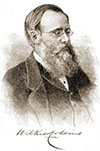


Please Contact Us if you have any questions or to report any problems.
PITHY QUOTE FROM Collins: Letters
In their devotion to their pursuits—tending to the peace and comfort of mankind—they are daily interrupted, harassed, worried, wearied, driven nearly mad, by street musicians. They are even made especial objects of persecution by brazen performers on brazen instruments, beaters of drums, grinders of organs, bangers of banjos, clashers of cymbals, worriers of fiddles, and bellowers of ballads; for, no sooner does it become known to those producers of horrible sounds that any of your correspondents have particular need of quiet in their own houses, than the said houses are beleaguered by discordant hosts seeking to be bought off.
The Letters of Wilkie Collins, [3205] TO MICHAEL T. BASS,1 MID MAY–EARLY JUNE 18642
|
Published as the frontispiece to the 30-volume Works of Wilkie Collins, Peter Fenelon Collier, New York 1900.
Based on F. Halpin’s engraving of a photograph of Wilkie Collins from the 1875 Chatto & Windus edition of My Miscellanies |
List of ContentsEach year the Wilkie Collins Society publishes a supplement to The Public Face: The Collected Letters of Wilkie Collins. The book and the supplements are edited by William Baker, Andrew Gasson, Graham Law, & Paul Lewis. The Public Face: The Collected Letters of Wilkie Collins, Pickering & Chatto, London 2005.
Addenda & Corrigenda (11) 2017 NotesThe new digital edition of the collected correspondence of Wilkie Collins incorporates and updates two earlier series by the same editors: the just under 3,000 letters included in the four volumes of The Public Face of Wilkie Collins: The Collected Letters (Pickering & Chatto, 2005); and the over 350 letters gradually added between 2005 and 2017 in the eleven numbers of The Collected Letters of Wilkie Collins: Addenda and Corrigenda issued by the Wilkie Collins Society. The process of updating includes a large number of corrections and revisions to both the letter transcripts and the accompanying editorial material, including in not a few cases changes involving the recipient and/or the dating. This is particularly so with the selection of nearly 600 letters initially published almost twenty years ago in The Letters of Wilkie Collins (2 vols; Macmillan, 1999), edited by William Baker and William M. Clarke. With few exceptions, these appeared in The Public Face only in summary form, but here all appear complete within the sequence, while the transcriptions and annotations alike have now been thoroughly revised. Wilkie Collins’s career as an author spans more than four decades, covering all but the opening and closing stages of the reign of Queen Victoria. During that lengthy period his writings offer a crucial witness – second in importance perhaps only to those of his mentor, collaborator, friend and rival Charles Dickens – to the gradual and uneven emergence in Britain of a mass literary culture. As a collection, Collins’s surviving correspondence ranges from the seven-year old child’s letter to his mother away at Brighton in the autumn of 1831 to the dying man’s desperate appeal to his old doctor friend in the autumn of 1889. His correspondents are active in an extraordinary range of cultural and social activities, and represent a wide variety of backgrounds and outlooks. There is a sustained dialogue with family members and relatives, with the companions made in youth (and often later with their partners and children), with new friends acquired on trips to Continental Europe or North America, with novelists, poets and painters, with playwrights, actors and theatre managers, with doctors, solicitors, and wine merchants, with publishers, editors, printers, copyists, and literary agents. Predictably, surviving correspondence with this last group is especially prominent. In addition there are hundreds of cases where there are only one or two letters to a single correspondent. Occasionally – as with Dickens – these are merely the fragments of a substantial relationship. More typically they bear witness to the growing fame of a writer who struggles to respond to an army of society hostesses, critical cranks, devoted readers and autograph hunters. Together these documents steadily chart the developments in a specific Victorian social and literary milieu. |
You are producing an outstandingly helpful scholarly resource of ever-increasing value. |
